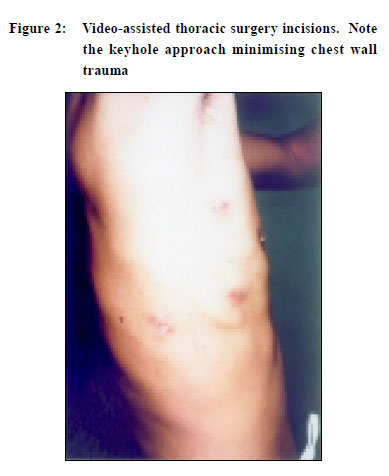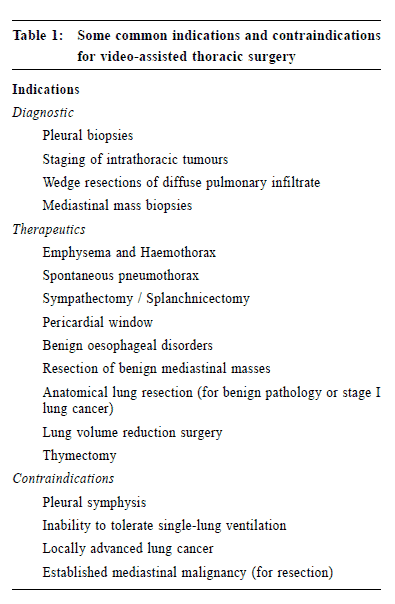
February 2001, Vol 23, No. 2 |
Update Articles
|
Video-assisted thoracic surgery – a more patient-friendly surgical approach to the management of intrathoracic conditionsA P C Yim HK Pract 2001;23:63-65 Summary The advent of videoendoscopy revolutionises the practice of surgery. Within a short span of time, videoassisted thoracic surgery (VATS) has become an acceptable approach to a wide range of thoracic procedures. By minimising chest wall trauma, postoperative pain is greatly reduced, hospital stay lessened and recovery accelerated. The use of VATS as a diagnostic modality is now well established. For therapeutic procedures, VATS has also been generally accepted for the treatment of conditions like primary spontaneous pneumothorax, loculated effusions, thoracodorsal sympathectomy for palmar hyperhidrosis and resection of benign mediastinal cysts. Technically advanced VATS procedures like thymectomy for myasthenia gravis and anatomical lung resections for early lung cancer are producing intermediate term results which are at least as good, if not superior to the conventional approaches. VATS is still in evolution. Miniaturisation of instruments promises to even further reduce access trauma. Introduction Posterolateral thoracotomy, being the conventional mode of access to the chest is arguably the most painful incision ever to be encountered by our patients (Figure 1). This is not only because of the length of incision or the transection of chest wall muscles, but mainly because ribs have to be forcefully spread in order to gain access into the chest. Post thoracotomy pain is often chronic and could be felt years and even decades after the operation, often precipitated by changes in weather. Hence, it is hardly surprising that within the last few years, videoassisted thoracic surgery (VATS) has rapidly become an established technique in thoracic surgery (Figure 2). A survey conducted among North American thoracic surgeons in 1995 showed VATS was among the preferred or accepted approach over a wide range of thoracic procedures.1 Recently, we conducted a similar questionnaire survey among thoracic surgeons in Australia, Asia, Europe and South America asking about the role of VATS in their practice, and their opinions regarding appropriate applications and limitations of the approach.2 Compared to the study conducted in North America 3 years ago, this survey showed increased acceptance of VATS for more complicated procedures like thymectomy and lobectomy. This may represent an increased acceptance of the VATS approach with time and experience.
Contraindications to VATS are relatively few. In addition to general contraindications like recent myocardial infarction and severe coagulopathy, specific contraindications include pleural symphysis and inability to tolerate selective one lung ventilation. The former is relatively uncommon and moderate adhesions could usually be taken down using a combination of sharp and blunt dissection under videoscopic vision. Prior operation in the ipsilateral chest should not be regarded as a contraindication.3 There is now a wealth of literature on VATS, and because of the low morbidity, good short and long term results, many VATS procedures are now well accepted as the approach of choice by the thoracic surgical community (Table 1).5 Detailed discussion of each procedure is beyond the scope of this article and the readers are referred to a specialised textbook on this subject.4
Other applications of VATS Many thoracic procedures are being rediscovered through the thoracoscope, some of these also involve the other surgical subspecialties. Thoracoscopic spinal surgery is receiving increasing attention by the orthopaedic community. For spinal deformity, anterior spinal release as well as instrumentation are now feasible.5 VATS is also playing an important role in minimal access cardiac surgery. The left internal mammary artery (LIMA) could be harvested with thoracoscopic assistance through an anterior minithoracotomy.6 This incision is subsequently used for the anastomosis of LIMA to the left anterior decending (LAD) coronary artery in a procedure now referred to as minimally invasive direct coronary artery bypass grafting (MIDCABG). The thoracoscope has also found use in minimal access mitral valve surgery and a totally endoscopic approach to valve replacement and coronary revascularisation (port access approach).7 Future prospects Cardiothoracic surgery is undergoing a rapid evolution as the development of videothoracoscopy has revolutionised its practice. The question now is, does VATS, as we currently practise it, represent an end point that only requires minor refinements or is it an intermediate step to an even less invasive approach? We believe that both views may be correct. VATS represents a spectrum with a purely endoscopic approach at one end and a video-assisted approach (with a utility minithoracotomy) at the other end. For the purely endoscopic procedures, there have been attempts to modify further the surgical access and mode of anaesthesia. The former resulted in the development of 2 mm “needlescopic” instrument8 and the latter in therapeutic thoracoscopy under local anaesthesia. It is entirely possible that in the near future, simple thoracoscopic procedures could be performed under local anaesthesia via an essentially percutaneous route with miniaturised instruments as an outpatient procedure. To summarise, VATS provides a much more patientfriendly surgical approach to the management of a wide variety of intrathoracic conditions. In many situations, the morbidity associated with a painful thoracotomy can now be avoided. Key messages
A P C Yim, DM(Oxon), FRCS(Eng), FACS, FHKAM Correspondence to : Prof A P C Yim, Division of Cardiothoracic Surgery, Department of Surgery, The Chinese University of Hong Kong, Prince of Wales Hospital, Shatin, N.T., Hong Kong. References
|
|


